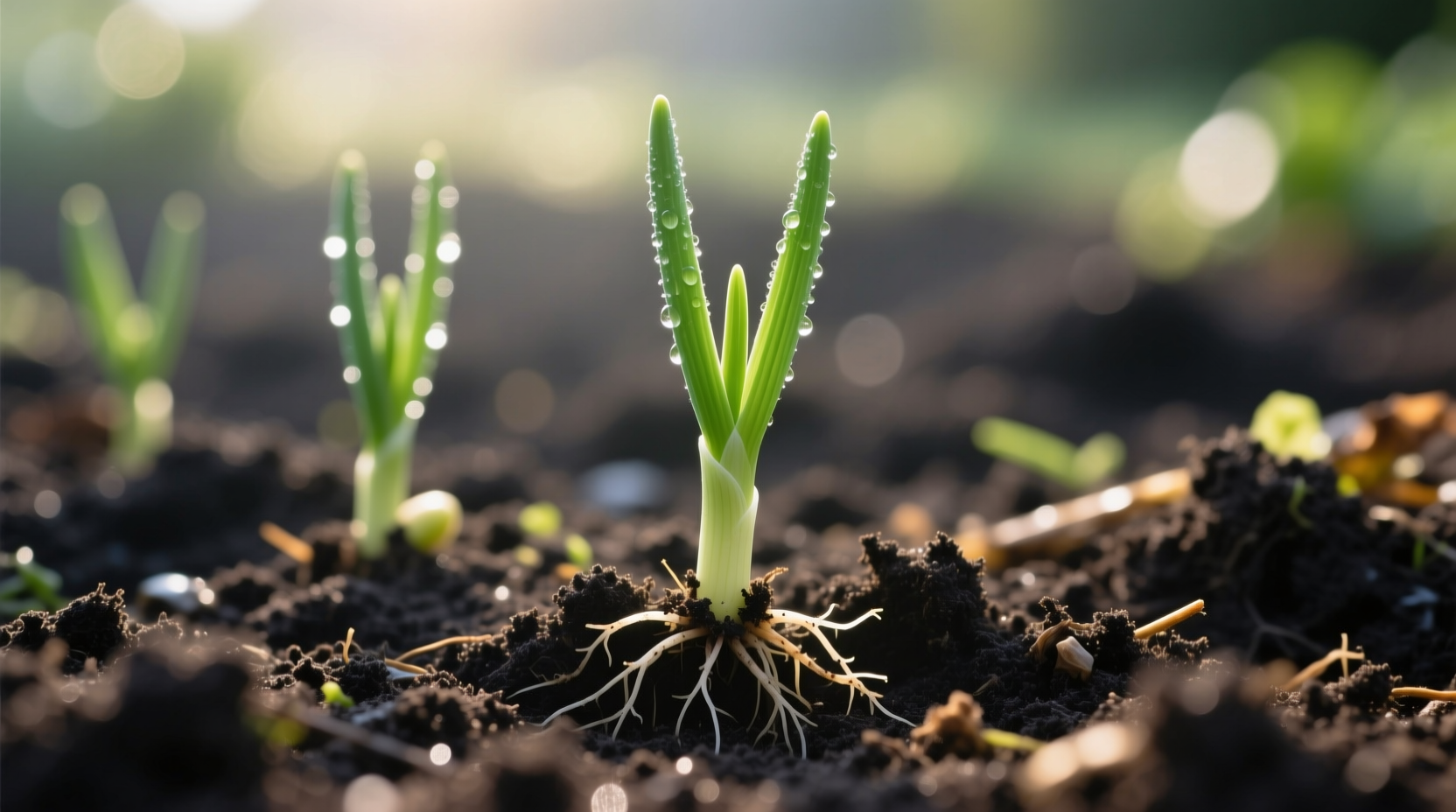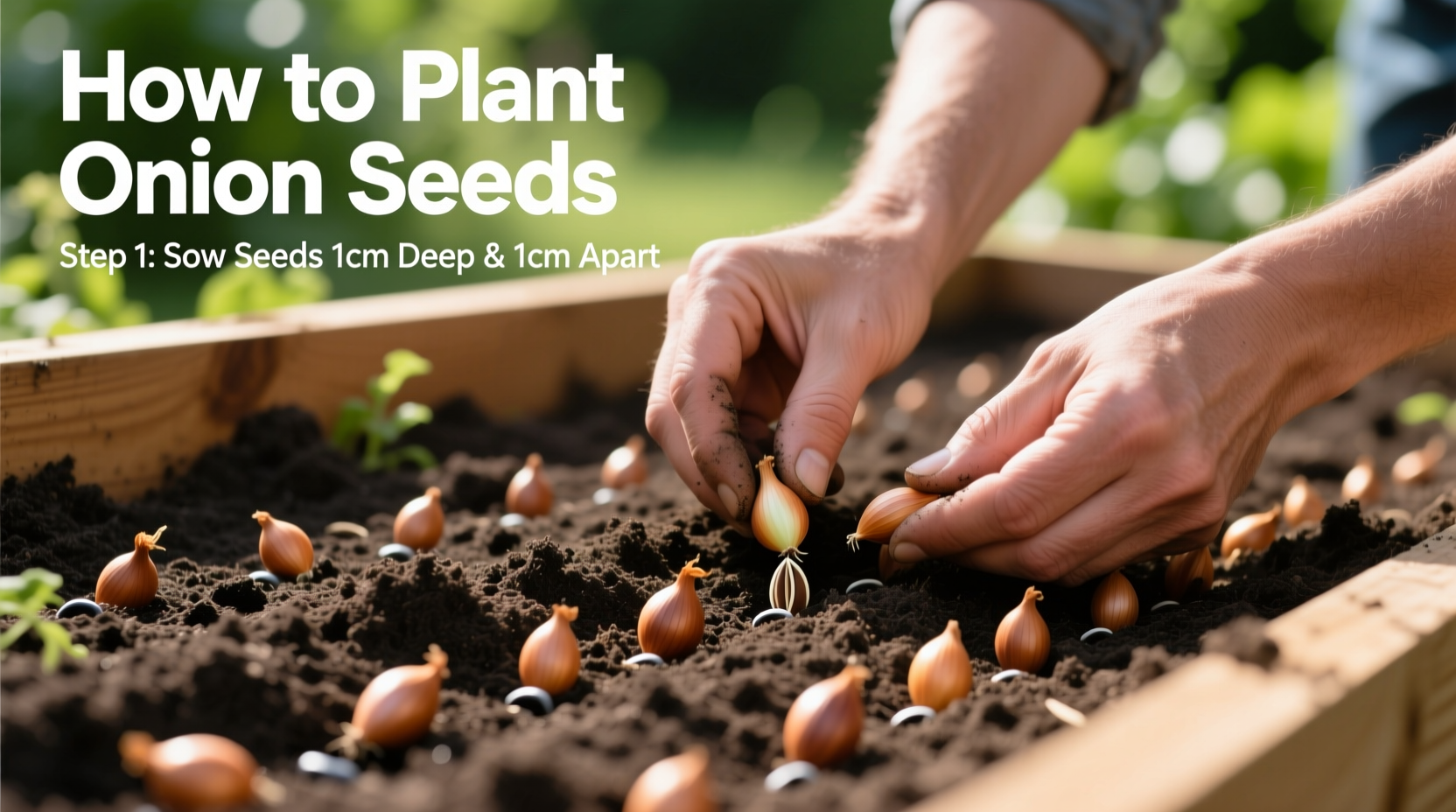Why This Onion Seed Planting Method Works
Many gardeners struggle with growing onions from seed, but following these science-backed techniques ensures healthy plants and maximum bulb size. Unlike sets or transplants, seeds offer more variety options and eliminate the risk of bolting that often plagues store-bought sets. Our guide combines agricultural research with practical gardening experience to help you grow perfect onions every time.
Onion Planting Timeline: From Seed to Harvest
Understanding the onion growth cycle helps you time your planting correctly. Onions require specific day lengths to form bulbs, making timing crucial for success. Here's the complete timeline for growing onions from seed:
| Stage | Timeframe | Critical Actions |
|---|---|---|
| Seed starting | 8-10 weeks pre-frost | Indoor sowing at 65-75°F soil temperature |
| Germination | 7-14 days | Maintain consistent moisture, 12-16 hours light |
| Hardening off | 7-10 days before transplant | Gradually expose to outdoor conditions |
| Transplanting | 2-3 weeks pre-frost | Plant 1-2 inches deep, 2-4 inches apart |
| Bulb formation | Spring/summer | Ensure adequate water, reduce nitrogen feeding |
| Harvesting | Late summer | When tops fall over naturally |
Regional Planting Considerations for Onion Success
Onion varieties respond differently to day length, making regional adaptation essential. The USDA Agricultural Research Service confirms that matching onion types to your latitude prevents premature bolting and ensures proper bulb formation:
- Short-day onions (10-12 hours daylight): Best for southern regions below 35° latitude (Texas, Florida). Plant in fall for spring harvest.
- Intermediate-day onions (12-14 hours): Suitable for central regions (35°-40° latitude). Plant in early spring.
- Long-day onions (14+ hours): Ideal for northern regions above 40° latitude. Plant as soon as soil can be worked in spring.
According to Cornell University's Cooperative Extension, planting long-day varieties too far south causes premature bulbing and small yields, while short-day varieties in northern regions won't bulb properly. Always check seed packets for day-length requirements specific to your region.
Step-by-Step Onion Seed Planting Guide
1. Timing Your Planting Correctly
Proper timing separates successful onion growers from those with disappointing results. Start seeds indoors 8-10 weeks before your last expected frost date. Use the USDA Plant Hardiness Zone Map to determine your specific frost dates. For direct sowing, wait until soil temperature reaches at least 50°F (10°C) consistently.
2. Soil Preparation Essentials
Onions thrive in loose, well-draining soil rich in organic matter. Prepare your garden bed by:
- Testing soil pH (ideal range 6.0-6.8) using a reliable kit
- Amending with 2-3 inches of compost worked into the top 6-8 inches of soil
- Adding balanced organic fertilizer (10-10-10) before planting
- Ensuring excellent drainage - raised beds work well in heavy soils
3. Starting Seeds Indoors
For strongest plants, start seeds indoors 8-10 weeks before transplanting:
- Fill seed trays with sterile seed starting mix
- Sow 2-3 seeds per cell ¼ inch deep
- Water gently and maintain soil temperature at 65-75°F
- Provide 12-16 hours of light daily (grow lights work best)
- Thin to strongest seedling when first true leaves appear
- Begin hardening off 7-10 days before transplanting
4. Transplanting Seedlings Outdoors
Transplant when seedlings reach pencil thickness and outdoor temperatures stay above 28°F (-2°C):
- Space plants 2-4 inches apart in rows 12-18 inches apart
- Plant so only the very tip of the seedling shows above soil
- Water immediately after planting with diluted seaweed solution
- Apply 2-inch mulch layer to conserve moisture and suppress weeds
5. Essential Care Through Growing Season
Consistent care ensures maximum bulb development:
- Watering: Provide 1 inch of water weekly, increasing during bulb formation
- Weeding: Hand-pull weeds carefully to avoid damaging shallow roots
- Fertilizing: Apply nitrogen-rich fertilizer every 3 weeks until bulbing begins
- Pest control: Monitor for thrips and onion maggots; use row covers for prevention
6. Harvesting and Curing Onions
Harvest when tops naturally fall over and turn yellow/brown:
- Carefully lift bulbs with garden fork
- Cure in warm, dry, well-ventilated area for 2-3 weeks
- Trim roots and tops to 1 inch after curing completes
- Store in mesh bags at 32-40°F with 65-70% humidity

Troubleshooting Common Onion Growing Problems
Poor Germination
If seeds fail to sprout within 14 days, check these factors:
- Soil temperature below 50°F (10°C) - use heating mat for indoor starts
- Old seeds - onion seeds remain viable for only 1-2 years
- Overwatering causing seed rot - maintain consistent but not soggy moisture
Bolting (Flower Stalk Formation)
Bolting ruins bulb development. Prevent it by:
- Using fresh seeds each year
- Avoiding exposure to temperatures below 50°F for extended periods
- Choosing appropriate day-length varieties for your region
Small Bulb Size
If bulbs remain small, consider these fixes:
- Overcrowding - thin plants to minimum 2-inch spacing
- Nitrogen deficiency - apply balanced fertilizer during leaf growth phase
- Incorrect day-length variety - verify your region's requirements
Maximizing Your Onion Harvest
For the best results, follow these professional tips:
- Rotate onion planting locations yearly to prevent disease buildup
- Plant onions with compatible companions like carrots and beets
- Avoid high-nitrogen fertilizers during bulb formation stage
- Stop watering 2-3 weeks before harvest to improve storage quality
Frequently Asked Questions
How deep should I plant onion seeds?
Plant onion seeds ¼ inch deep in loose soil. Deeper planting can prevent germination, while shallow planting may cause seeds to dry out. When transplanting seedlings, bury them up to the first set of leaves.
Can I plant onion seeds directly in the garden?
Yes, you can direct sow onion seeds when soil temperature reaches 50°F (10°C). However, starting seeds indoors 8-10 weeks before last frost gives you a head start and typically produces larger bulbs. Direct sowing works best in regions with long growing seasons.
How long does it take for onion seeds to germinate?
Onion seeds typically germinate in 7-14 days when soil temperature is maintained between 60-75°F (15-24°C). Cooler temperatures slow germination, while temperatures above 80°F (27°C) can inhibit it. Consistent moisture is critical during this period.
Why are my onion plants falling over?
Onion tops naturally fall over when bulbs have matured and it's time to harvest. This happens as the plant redirects energy from leaves to bulb development. If plants fall over prematurely, it could indicate disease, pest damage, or excessive nitrogen feeding.
How do I prevent onion maggots in my garden?
Prevent onion maggots by rotating crops yearly, using floating row covers from planting through early summer, and applying beneficial nematodes to the soil. Avoid planting onions in soil where brassicas grew the previous year, as both attract similar pests.











 浙公网安备
33010002000092号
浙公网安备
33010002000092号 浙B2-20120091-4
浙B2-20120091-4